Innovating Australia's Transport: A Strategic Report on 2030-2040
VerifiedAdded on 2023/06/15
|11
|2445
|249
Report
AI Summary
This report provides a comprehensive analysis of the future of Australian transport, focusing on the period between 2030 and 2040. It examines key strategic certainties and trends, such as the increasing automation of vehicles and the growing emphasis on sustainable transport solutions. It also addresses strategic uncertainties, including the public's acceptance of driverless vehicles and the potential challenges in achieving ambitious goals related to commuting distances. Key drivers shaping the future of transport, such as automation, shared mobility, data availability, and consumer demand, are explored in detail. The report presents a working theory that envisions a future where automatic vehicles, shared rides, and data-driven traffic management systems are prevalent. The report concludes by emphasizing the importance of innovation and strategic planning in revolutionizing Australia's transport system.
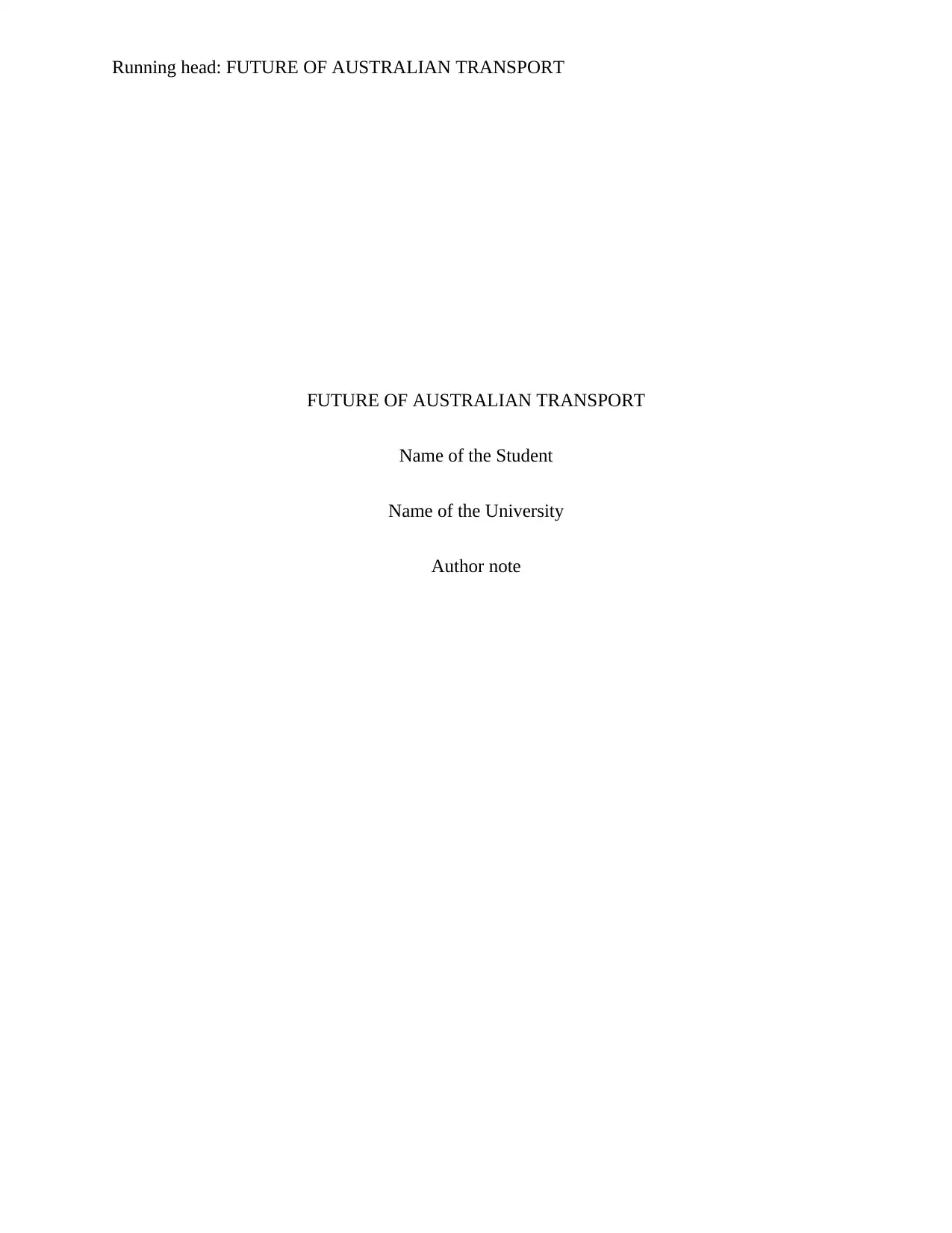
Running head: FUTURE OF AUSTRALIAN TRANSPORT
FUTURE OF AUSTRALIAN TRANSPORT
Name of the Student
Name of the University
Author note
FUTURE OF AUSTRALIAN TRANSPORT
Name of the Student
Name of the University
Author note
Paraphrase This Document
Need a fresh take? Get an instant paraphrase of this document with our AI Paraphraser
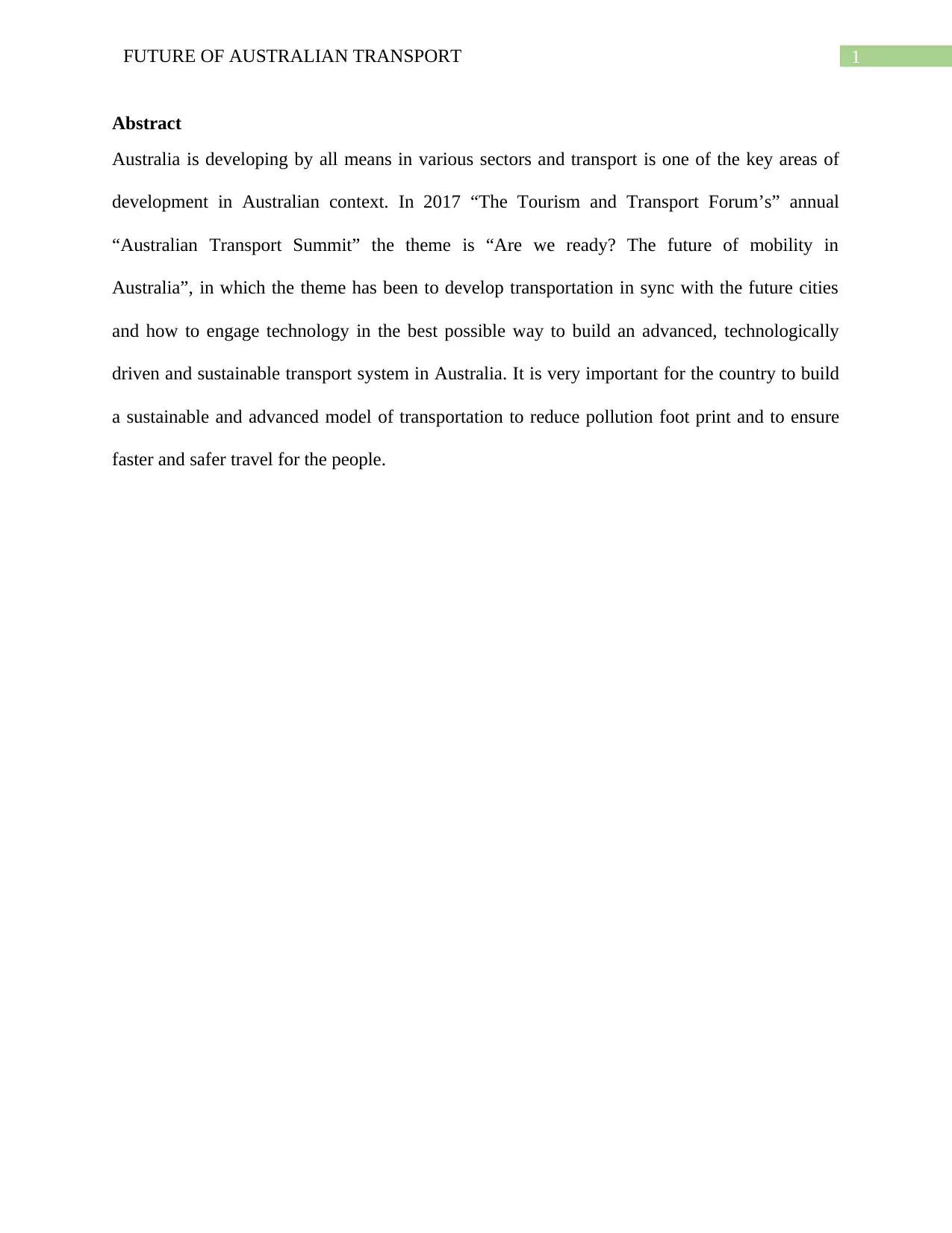
1FUTURE OF AUSTRALIAN TRANSPORT
Abstract
Australia is developing by all means in various sectors and transport is one of the key areas of
development in Australian context. In 2017 “The Tourism and Transport Forum’s” annual
“Australian Transport Summit” the theme is “Are we ready? The future of mobility in
Australia”, in which the theme has been to develop transportation in sync with the future cities
and how to engage technology in the best possible way to build an advanced, technologically
driven and sustainable transport system in Australia. It is very important for the country to build
a sustainable and advanced model of transportation to reduce pollution foot print and to ensure
faster and safer travel for the people.
Abstract
Australia is developing by all means in various sectors and transport is one of the key areas of
development in Australian context. In 2017 “The Tourism and Transport Forum’s” annual
“Australian Transport Summit” the theme is “Are we ready? The future of mobility in
Australia”, in which the theme has been to develop transportation in sync with the future cities
and how to engage technology in the best possible way to build an advanced, technologically
driven and sustainable transport system in Australia. It is very important for the country to build
a sustainable and advanced model of transportation to reduce pollution foot print and to ensure
faster and safer travel for the people.
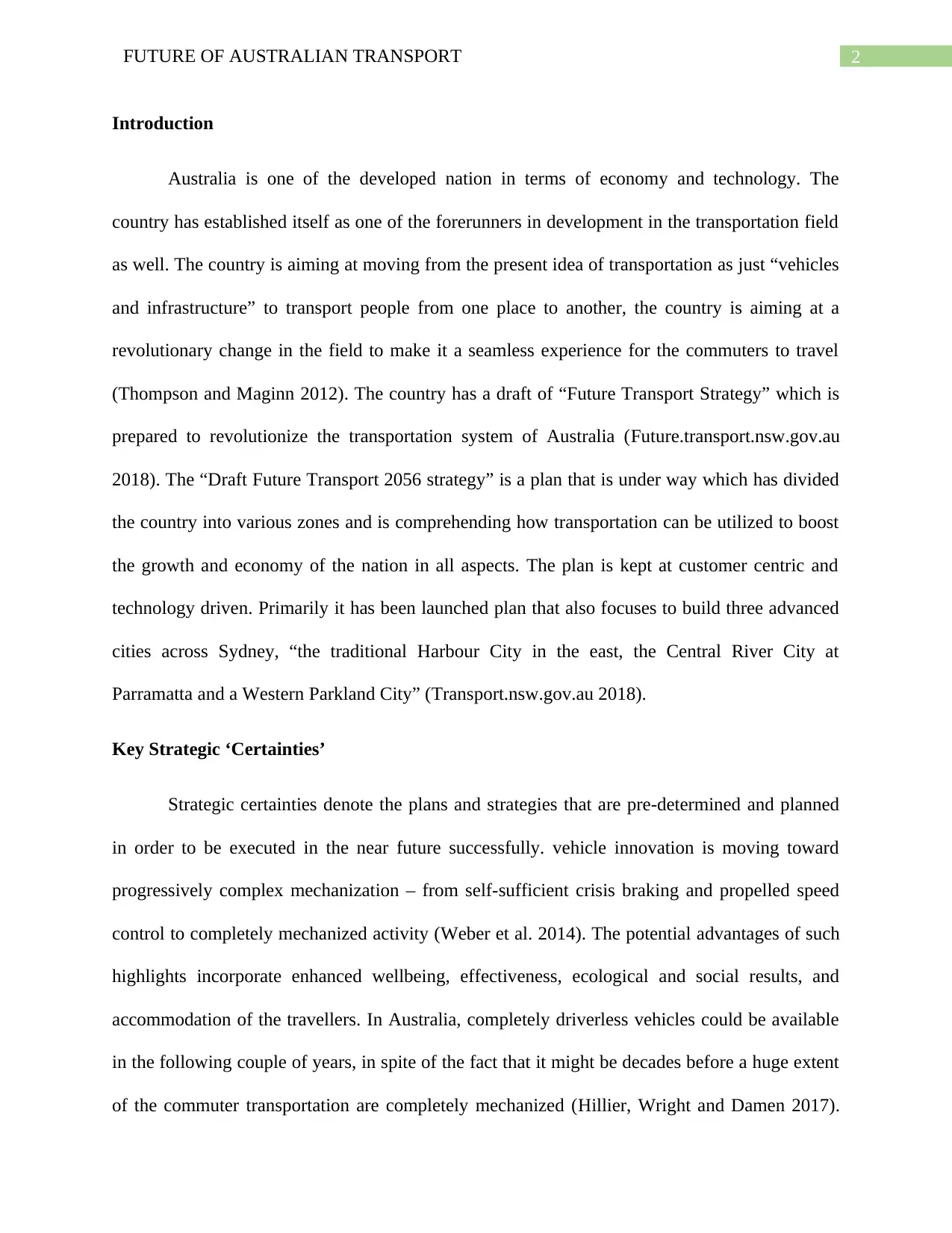
2FUTURE OF AUSTRALIAN TRANSPORT
Introduction
Australia is one of the developed nation in terms of economy and technology. The
country has established itself as one of the forerunners in development in the transportation field
as well. The country is aiming at moving from the present idea of transportation as just “vehicles
and infrastructure” to transport people from one place to another, the country is aiming at a
revolutionary change in the field to make it a seamless experience for the commuters to travel
(Thompson and Maginn 2012). The country has a draft of “Future Transport Strategy” which is
prepared to revolutionize the transportation system of Australia (Future.transport.nsw.gov.au
2018). The “Draft Future Transport 2056 strategy” is a plan that is under way which has divided
the country into various zones and is comprehending how transportation can be utilized to boost
the growth and economy of the nation in all aspects. The plan is kept at customer centric and
technology driven. Primarily it has been launched plan that also focuses to build three advanced
cities across Sydney, “the traditional Harbour City in the east, the Central River City at
Parramatta and a Western Parkland City” (Transport.nsw.gov.au 2018).
Key Strategic ‘Certainties’
Strategic certainties denote the plans and strategies that are pre-determined and planned
in order to be executed in the near future successfully. vehicle innovation is moving toward
progressively complex mechanization – from self-sufficient crisis braking and propelled speed
control to completely mechanized activity (Weber et al. 2014). The potential advantages of such
highlights incorporate enhanced wellbeing, effectiveness, ecological and social results, and
accommodation of the travellers. In Australia, completely driverless vehicles could be available
in the following couple of years, in spite of the fact that it might be decades before a huge extent
of the commuter transportation are completely mechanized (Hillier, Wright and Damen 2017).
Introduction
Australia is one of the developed nation in terms of economy and technology. The
country has established itself as one of the forerunners in development in the transportation field
as well. The country is aiming at moving from the present idea of transportation as just “vehicles
and infrastructure” to transport people from one place to another, the country is aiming at a
revolutionary change in the field to make it a seamless experience for the commuters to travel
(Thompson and Maginn 2012). The country has a draft of “Future Transport Strategy” which is
prepared to revolutionize the transportation system of Australia (Future.transport.nsw.gov.au
2018). The “Draft Future Transport 2056 strategy” is a plan that is under way which has divided
the country into various zones and is comprehending how transportation can be utilized to boost
the growth and economy of the nation in all aspects. The plan is kept at customer centric and
technology driven. Primarily it has been launched plan that also focuses to build three advanced
cities across Sydney, “the traditional Harbour City in the east, the Central River City at
Parramatta and a Western Parkland City” (Transport.nsw.gov.au 2018).
Key Strategic ‘Certainties’
Strategic certainties denote the plans and strategies that are pre-determined and planned
in order to be executed in the near future successfully. vehicle innovation is moving toward
progressively complex mechanization – from self-sufficient crisis braking and propelled speed
control to completely mechanized activity (Weber et al. 2014). The potential advantages of such
highlights incorporate enhanced wellbeing, effectiveness, ecological and social results, and
accommodation of the travellers. In Australia, completely driverless vehicles could be available
in the following couple of years, in spite of the fact that it might be decades before a huge extent
of the commuter transportation are completely mechanized (Hillier, Wright and Damen 2017).
⊘ This is a preview!⊘
Do you want full access?
Subscribe today to unlock all pages.

Trusted by 1+ million students worldwide
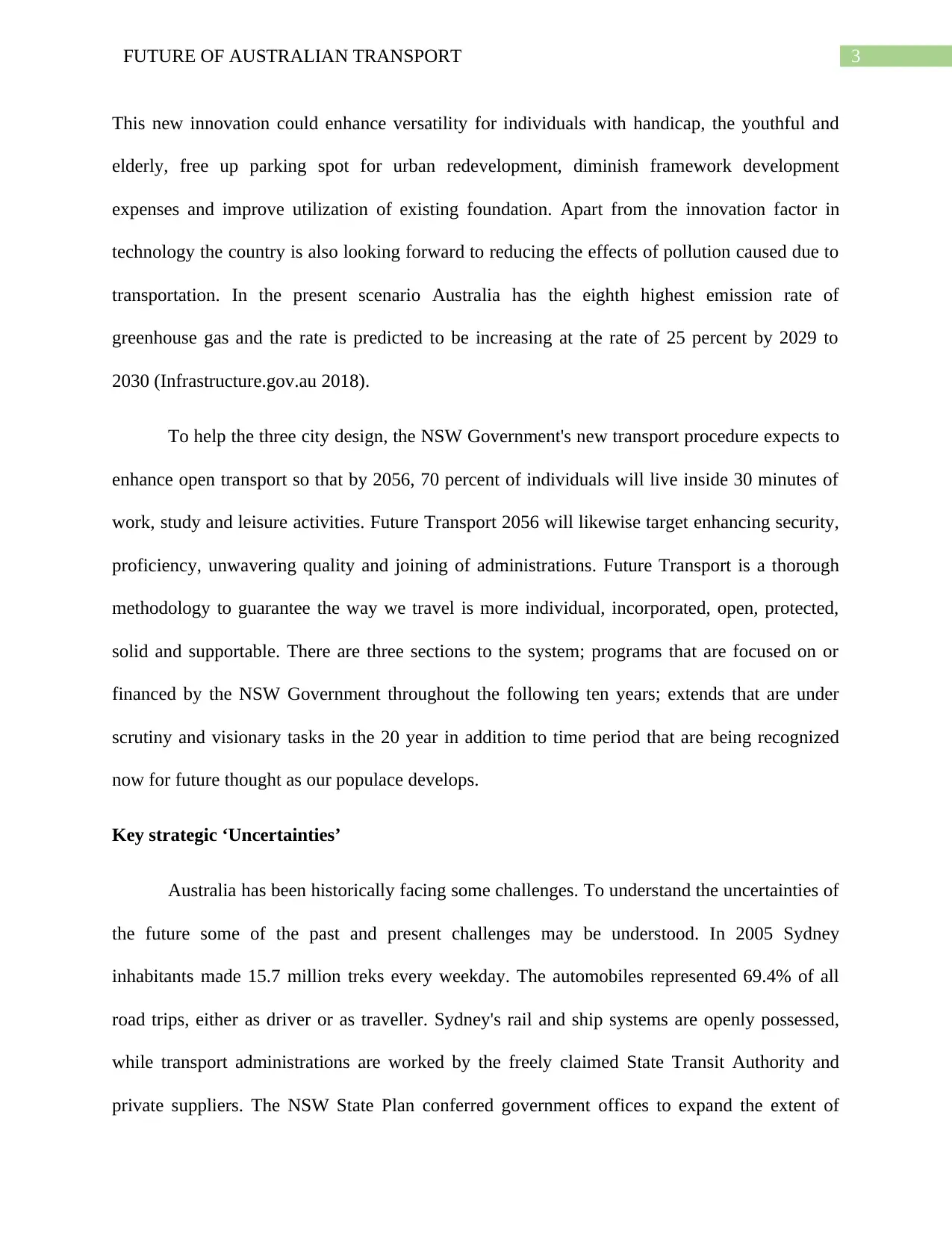
3FUTURE OF AUSTRALIAN TRANSPORT
This new innovation could enhance versatility for individuals with handicap, the youthful and
elderly, free up parking spot for urban redevelopment, diminish framework development
expenses and improve utilization of existing foundation. Apart from the innovation factor in
technology the country is also looking forward to reducing the effects of pollution caused due to
transportation. In the present scenario Australia has the eighth highest emission rate of
greenhouse gas and the rate is predicted to be increasing at the rate of 25 percent by 2029 to
2030 (Infrastructure.gov.au 2018).
To help the three city design, the NSW Government's new transport procedure expects to
enhance open transport so that by 2056, 70 percent of individuals will live inside 30 minutes of
work, study and leisure activities. Future Transport 2056 will likewise target enhancing security,
proficiency, unwavering quality and joining of administrations. Future Transport is a thorough
methodology to guarantee the way we travel is more individual, incorporated, open, protected,
solid and supportable. There are three sections to the system; programs that are focused on or
financed by the NSW Government throughout the following ten years; extends that are under
scrutiny and visionary tasks in the 20 year in addition to time period that are being recognized
now for future thought as our populace develops.
Key strategic ‘Uncertainties’
Australia has been historically facing some challenges. To understand the uncertainties of
the future some of the past and present challenges may be understood. In 2005 Sydney
inhabitants made 15.7 million treks every weekday. The automobiles represented 69.4% of all
road trips, either as driver or as traveller. Sydney's rail and ship systems are openly possessed,
while transport administrations are worked by the freely claimed State Transit Authority and
private suppliers. The NSW State Plan conferred government offices to expand the extent of
This new innovation could enhance versatility for individuals with handicap, the youthful and
elderly, free up parking spot for urban redevelopment, diminish framework development
expenses and improve utilization of existing foundation. Apart from the innovation factor in
technology the country is also looking forward to reducing the effects of pollution caused due to
transportation. In the present scenario Australia has the eighth highest emission rate of
greenhouse gas and the rate is predicted to be increasing at the rate of 25 percent by 2029 to
2030 (Infrastructure.gov.au 2018).
To help the three city design, the NSW Government's new transport procedure expects to
enhance open transport so that by 2056, 70 percent of individuals will live inside 30 minutes of
work, study and leisure activities. Future Transport 2056 will likewise target enhancing security,
proficiency, unwavering quality and joining of administrations. Future Transport is a thorough
methodology to guarantee the way we travel is more individual, incorporated, open, protected,
solid and supportable. There are three sections to the system; programs that are focused on or
financed by the NSW Government throughout the following ten years; extends that are under
scrutiny and visionary tasks in the 20 year in addition to time period that are being recognized
now for future thought as our populace develops.
Key strategic ‘Uncertainties’
Australia has been historically facing some challenges. To understand the uncertainties of
the future some of the past and present challenges may be understood. In 2005 Sydney
inhabitants made 15.7 million treks every weekday. The automobiles represented 69.4% of all
road trips, either as driver or as traveller. Sydney's rail and ship systems are openly possessed,
while transport administrations are worked by the freely claimed State Transit Authority and
private suppliers. The NSW State Plan conferred government offices to expand the extent of
Paraphrase This Document
Need a fresh take? Get an instant paraphrase of this document with our AI Paraphraser
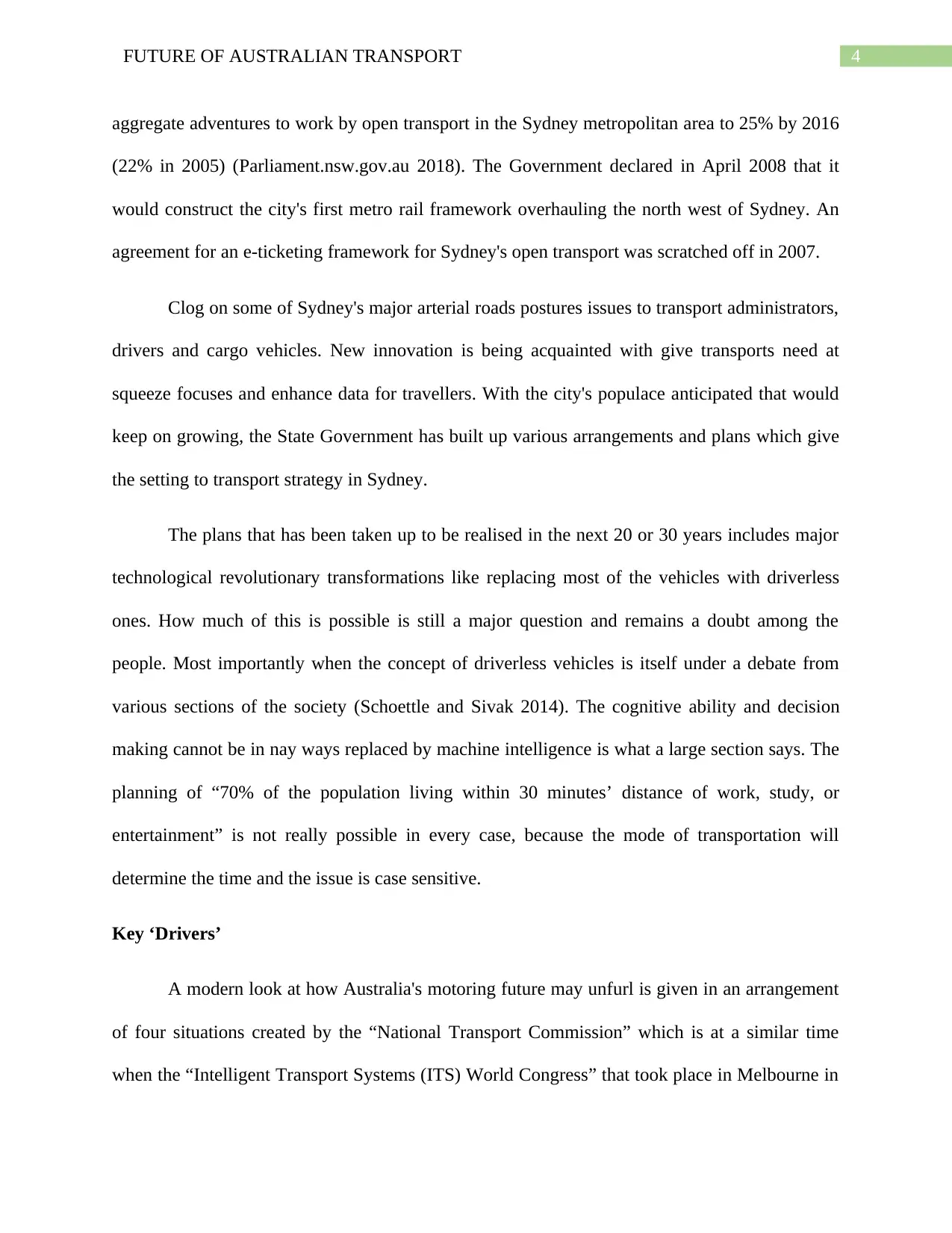
4FUTURE OF AUSTRALIAN TRANSPORT
aggregate adventures to work by open transport in the Sydney metropolitan area to 25% by 2016
(22% in 2005) (Parliament.nsw.gov.au 2018). The Government declared in April 2008 that it
would construct the city's first metro rail framework overhauling the north west of Sydney. An
agreement for an e-ticketing framework for Sydney's open transport was scratched off in 2007.
Clog on some of Sydney's major arterial roads postures issues to transport administrators,
drivers and cargo vehicles. New innovation is being acquainted with give transports need at
squeeze focuses and enhance data for travellers. With the city's populace anticipated that would
keep on growing, the State Government has built up various arrangements and plans which give
the setting to transport strategy in Sydney.
The plans that has been taken up to be realised in the next 20 or 30 years includes major
technological revolutionary transformations like replacing most of the vehicles with driverless
ones. How much of this is possible is still a major question and remains a doubt among the
people. Most importantly when the concept of driverless vehicles is itself under a debate from
various sections of the society (Schoettle and Sivak 2014). The cognitive ability and decision
making cannot be in nay ways replaced by machine intelligence is what a large section says. The
planning of “70% of the population living within 30 minutes’ distance of work, study, or
entertainment” is not really possible in every case, because the mode of transportation will
determine the time and the issue is case sensitive.
Key ‘Drivers’
A modern look at how Australia's motoring future may unfurl is given in an arrangement
of four situations created by the “National Transport Commission” which is at a similar time
when the “Intelligent Transport Systems (ITS) World Congress” that took place in Melbourne in
aggregate adventures to work by open transport in the Sydney metropolitan area to 25% by 2016
(22% in 2005) (Parliament.nsw.gov.au 2018). The Government declared in April 2008 that it
would construct the city's first metro rail framework overhauling the north west of Sydney. An
agreement for an e-ticketing framework for Sydney's open transport was scratched off in 2007.
Clog on some of Sydney's major arterial roads postures issues to transport administrators,
drivers and cargo vehicles. New innovation is being acquainted with give transports need at
squeeze focuses and enhance data for travellers. With the city's populace anticipated that would
keep on growing, the State Government has built up various arrangements and plans which give
the setting to transport strategy in Sydney.
The plans that has been taken up to be realised in the next 20 or 30 years includes major
technological revolutionary transformations like replacing most of the vehicles with driverless
ones. How much of this is possible is still a major question and remains a doubt among the
people. Most importantly when the concept of driverless vehicles is itself under a debate from
various sections of the society (Schoettle and Sivak 2014). The cognitive ability and decision
making cannot be in nay ways replaced by machine intelligence is what a large section says. The
planning of “70% of the population living within 30 minutes’ distance of work, study, or
entertainment” is not really possible in every case, because the mode of transportation will
determine the time and the issue is case sensitive.
Key ‘Drivers’
A modern look at how Australia's motoring future may unfurl is given in an arrangement
of four situations created by the “National Transport Commission” which is at a similar time
when the “Intelligent Transport Systems (ITS) World Congress” that took place in Melbourne in
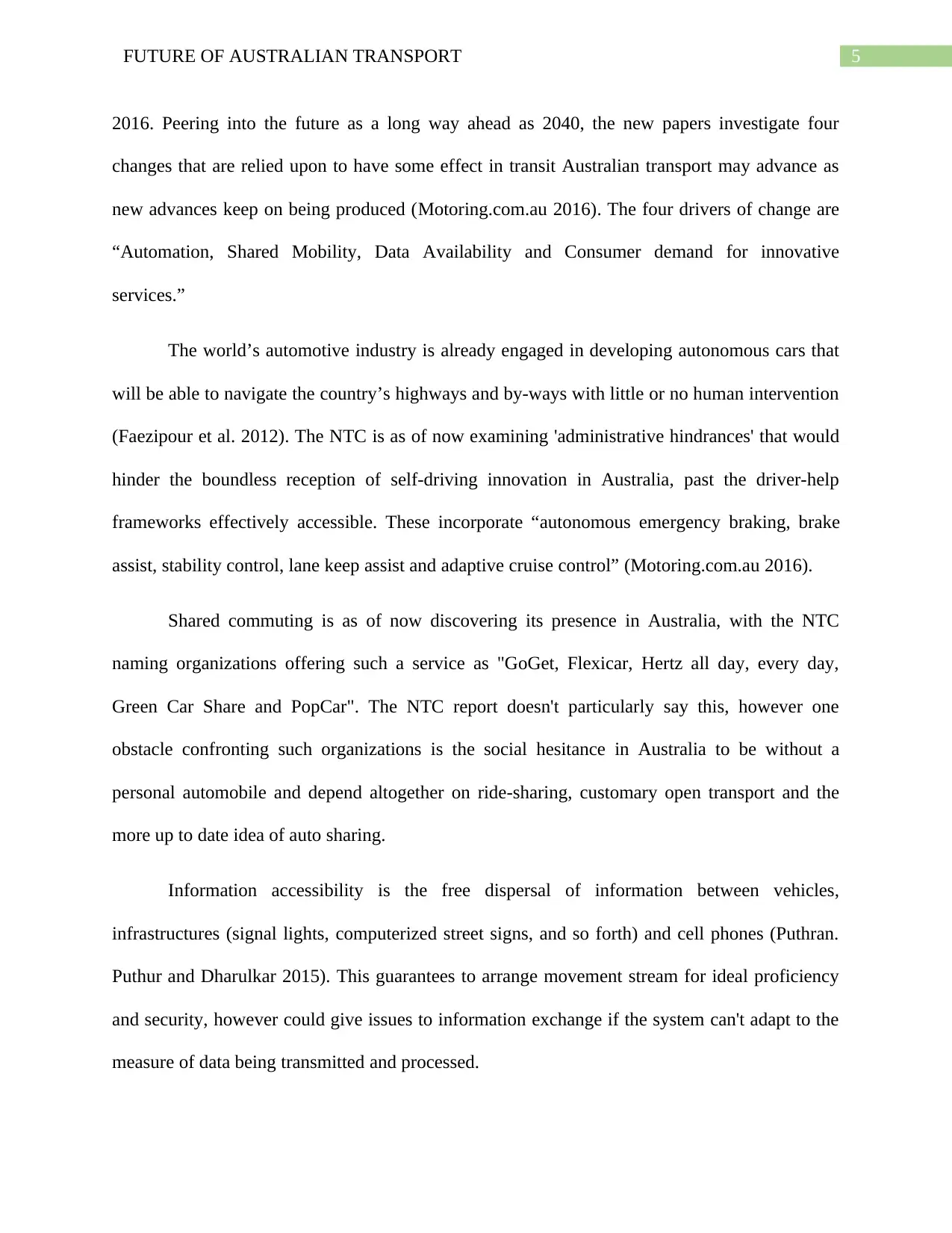
5FUTURE OF AUSTRALIAN TRANSPORT
2016. Peering into the future as a long way ahead as 2040, the new papers investigate four
changes that are relied upon to have some effect in transit Australian transport may advance as
new advances keep on being produced (Motoring.com.au 2016). The four drivers of change are
“Automation, Shared Mobility, Data Availability and Consumer demand for innovative
services.”
The world’s automotive industry is already engaged in developing autonomous cars that
will be able to navigate the country’s highways and by-ways with little or no human intervention
(Faezipour et al. 2012). The NTC is as of now examining 'administrative hindrances' that would
hinder the boundless reception of self-driving innovation in Australia, past the driver-help
frameworks effectively accessible. These incorporate “autonomous emergency braking, brake
assist, stability control, lane keep assist and adaptive cruise control” (Motoring.com.au 2016).
Shared commuting is as of now discovering its presence in Australia, with the NTC
naming organizations offering such a service as "GoGet, Flexicar, Hertz all day, every day,
Green Car Share and PopCar". The NTC report doesn't particularly say this, however one
obstacle confronting such organizations is the social hesitance in Australia to be without a
personal automobile and depend altogether on ride-sharing, customary open transport and the
more up to date idea of auto sharing.
Information accessibility is the free dispersal of information between vehicles,
infrastructures (signal lights, computerized street signs, and so forth) and cell phones (Puthran.
Puthur and Dharulkar 2015). This guarantees to arrange movement stream for ideal proficiency
and security, however could give issues to information exchange if the system can't adapt to the
measure of data being transmitted and processed.
2016. Peering into the future as a long way ahead as 2040, the new papers investigate four
changes that are relied upon to have some effect in transit Australian transport may advance as
new advances keep on being produced (Motoring.com.au 2016). The four drivers of change are
“Automation, Shared Mobility, Data Availability and Consumer demand for innovative
services.”
The world’s automotive industry is already engaged in developing autonomous cars that
will be able to navigate the country’s highways and by-ways with little or no human intervention
(Faezipour et al. 2012). The NTC is as of now examining 'administrative hindrances' that would
hinder the boundless reception of self-driving innovation in Australia, past the driver-help
frameworks effectively accessible. These incorporate “autonomous emergency braking, brake
assist, stability control, lane keep assist and adaptive cruise control” (Motoring.com.au 2016).
Shared commuting is as of now discovering its presence in Australia, with the NTC
naming organizations offering such a service as "GoGet, Flexicar, Hertz all day, every day,
Green Car Share and PopCar". The NTC report doesn't particularly say this, however one
obstacle confronting such organizations is the social hesitance in Australia to be without a
personal automobile and depend altogether on ride-sharing, customary open transport and the
more up to date idea of auto sharing.
Information accessibility is the free dispersal of information between vehicles,
infrastructures (signal lights, computerized street signs, and so forth) and cell phones (Puthran.
Puthur and Dharulkar 2015). This guarantees to arrange movement stream for ideal proficiency
and security, however could give issues to information exchange if the system can't adapt to the
measure of data being transmitted and processed.
⊘ This is a preview!⊘
Do you want full access?
Subscribe today to unlock all pages.

Trusted by 1+ million students worldwide
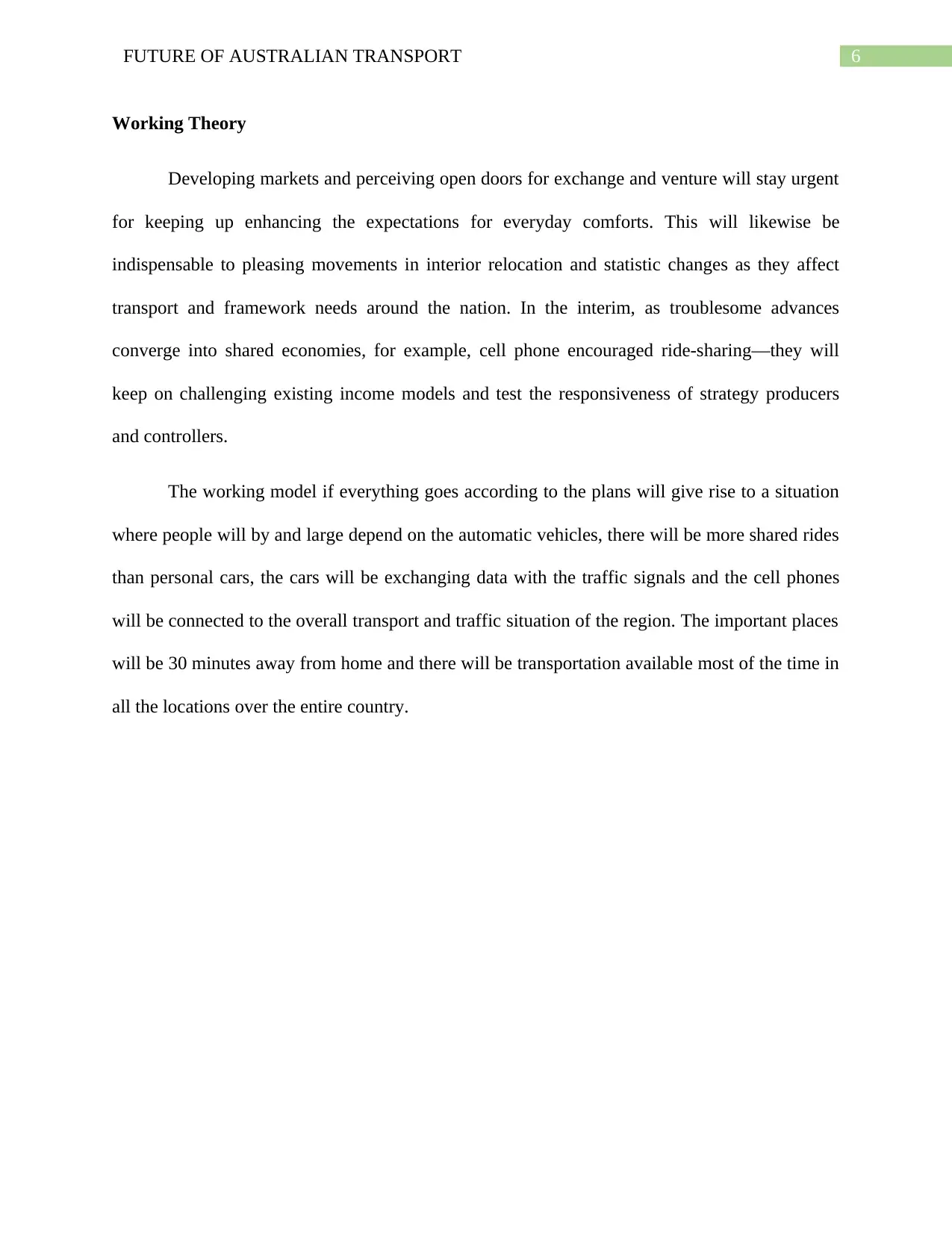
6FUTURE OF AUSTRALIAN TRANSPORT
Working Theory
Developing markets and perceiving open doors for exchange and venture will stay urgent
for keeping up enhancing the expectations for everyday comforts. This will likewise be
indispensable to pleasing movements in interior relocation and statistic changes as they affect
transport and framework needs around the nation. In the interim, as troublesome advances
converge into shared economies, for example, cell phone encouraged ride-sharing—they will
keep on challenging existing income models and test the responsiveness of strategy producers
and controllers.
The working model if everything goes according to the plans will give rise to a situation
where people will by and large depend on the automatic vehicles, there will be more shared rides
than personal cars, the cars will be exchanging data with the traffic signals and the cell phones
will be connected to the overall transport and traffic situation of the region. The important places
will be 30 minutes away from home and there will be transportation available most of the time in
all the locations over the entire country.
Working Theory
Developing markets and perceiving open doors for exchange and venture will stay urgent
for keeping up enhancing the expectations for everyday comforts. This will likewise be
indispensable to pleasing movements in interior relocation and statistic changes as they affect
transport and framework needs around the nation. In the interim, as troublesome advances
converge into shared economies, for example, cell phone encouraged ride-sharing—they will
keep on challenging existing income models and test the responsiveness of strategy producers
and controllers.
The working model if everything goes according to the plans will give rise to a situation
where people will by and large depend on the automatic vehicles, there will be more shared rides
than personal cars, the cars will be exchanging data with the traffic signals and the cell phones
will be connected to the overall transport and traffic situation of the region. The important places
will be 30 minutes away from home and there will be transportation available most of the time in
all the locations over the entire country.
Paraphrase This Document
Need a fresh take? Get an instant paraphrase of this document with our AI Paraphraser
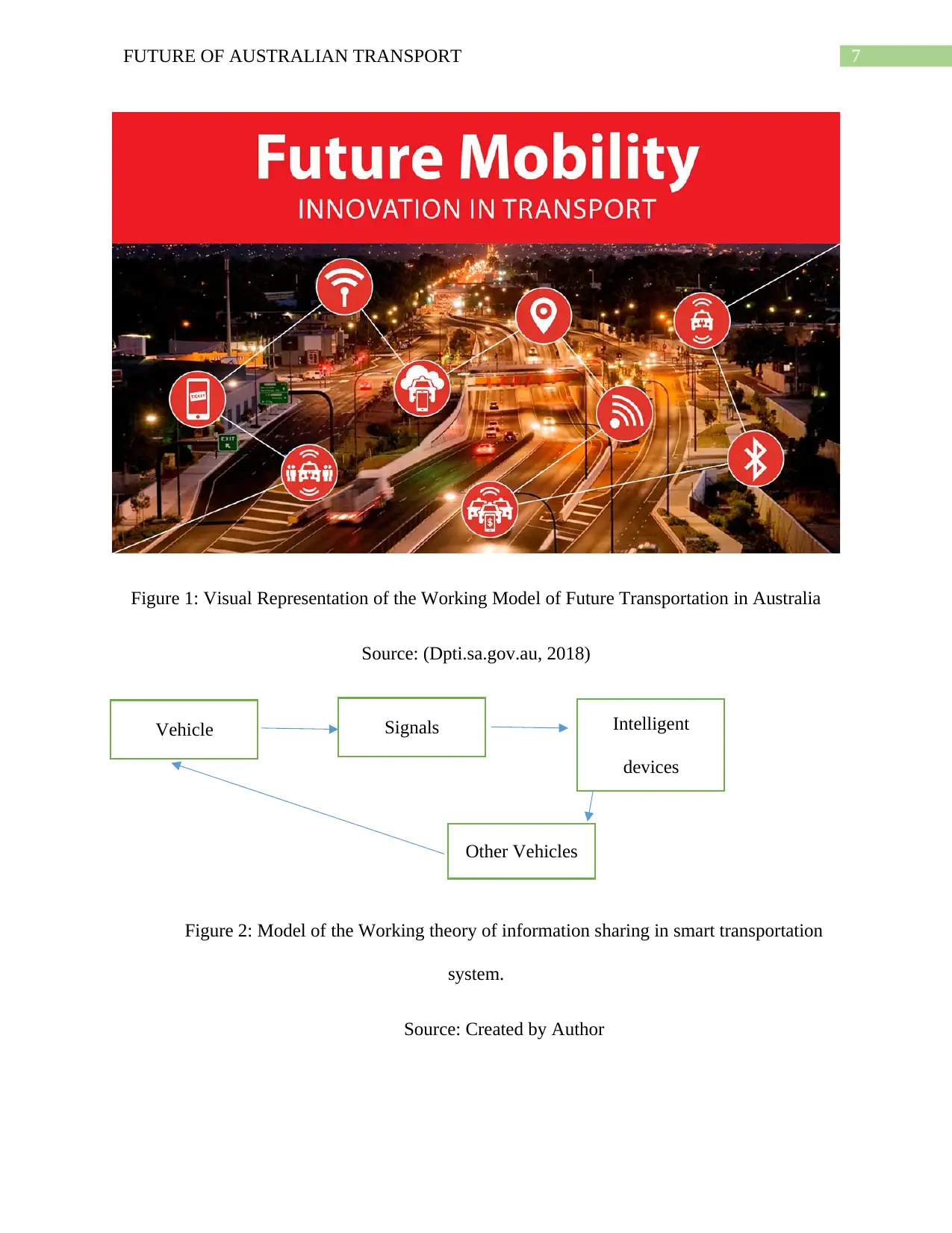
7FUTURE OF AUSTRALIAN TRANSPORT
Figure 1: Visual Representation of the Working Model of Future Transportation in Australia
Source: (Dpti.sa.gov.au, 2018)
Figure 2: Model of the Working theory of information sharing in smart transportation
system.
Source: Created by Author
Vehicle Signals Intelligent
devices
Other Vehicles
Figure 1: Visual Representation of the Working Model of Future Transportation in Australia
Source: (Dpti.sa.gov.au, 2018)
Figure 2: Model of the Working theory of information sharing in smart transportation
system.
Source: Created by Author
Vehicle Signals Intelligent
devices
Other Vehicles
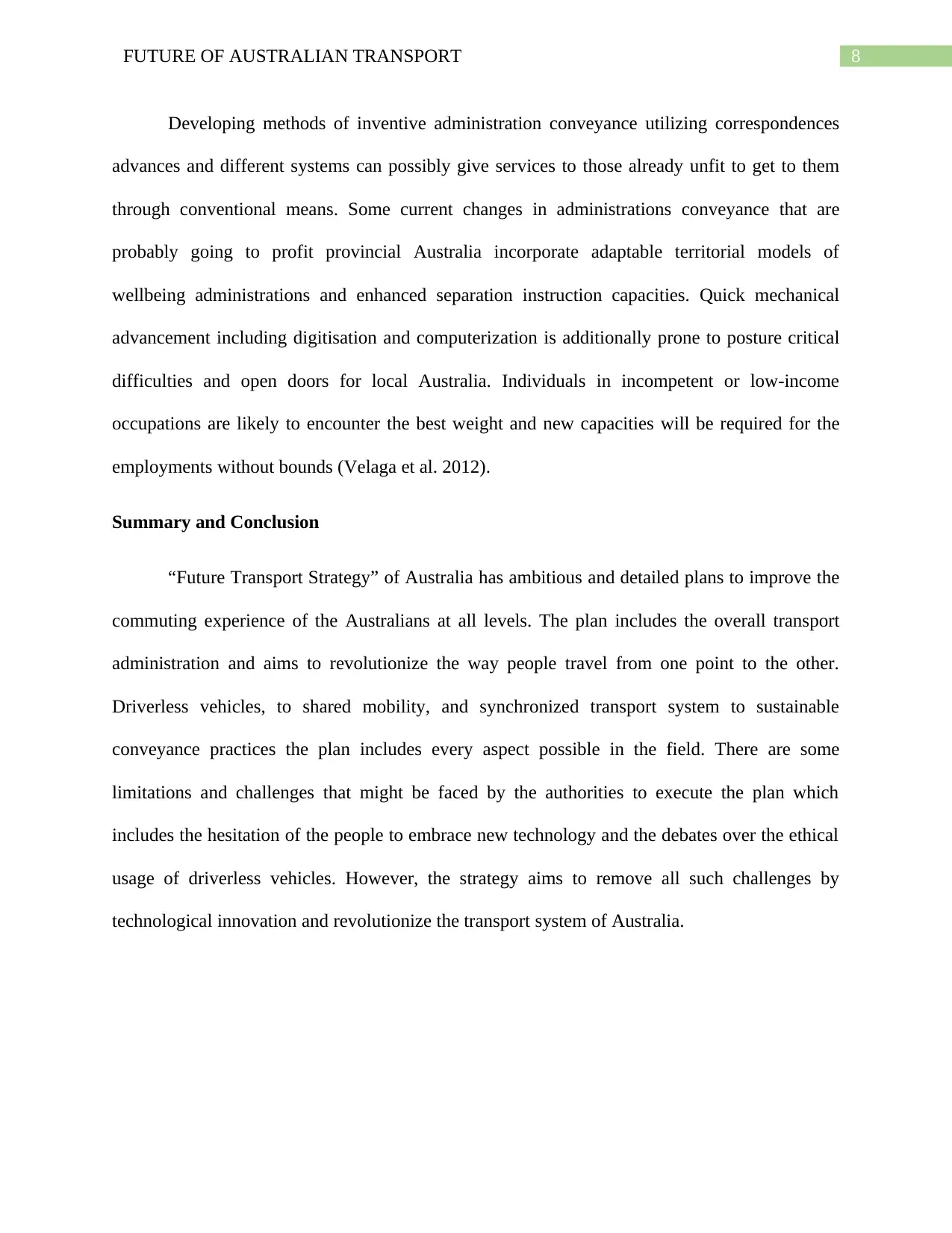
8FUTURE OF AUSTRALIAN TRANSPORT
Developing methods of inventive administration conveyance utilizing correspondences
advances and different systems can possibly give services to those already unfit to get to them
through conventional means. Some current changes in administrations conveyance that are
probably going to profit provincial Australia incorporate adaptable territorial models of
wellbeing administrations and enhanced separation instruction capacities. Quick mechanical
advancement including digitisation and computerization is additionally prone to posture critical
difficulties and open doors for local Australia. Individuals in incompetent or low-income
occupations are likely to encounter the best weight and new capacities will be required for the
employments without bounds (Velaga et al. 2012).
Summary and Conclusion
“Future Transport Strategy” of Australia has ambitious and detailed plans to improve the
commuting experience of the Australians at all levels. The plan includes the overall transport
administration and aims to revolutionize the way people travel from one point to the other.
Driverless vehicles, to shared mobility, and synchronized transport system to sustainable
conveyance practices the plan includes every aspect possible in the field. There are some
limitations and challenges that might be faced by the authorities to execute the plan which
includes the hesitation of the people to embrace new technology and the debates over the ethical
usage of driverless vehicles. However, the strategy aims to remove all such challenges by
technological innovation and revolutionize the transport system of Australia.
Developing methods of inventive administration conveyance utilizing correspondences
advances and different systems can possibly give services to those already unfit to get to them
through conventional means. Some current changes in administrations conveyance that are
probably going to profit provincial Australia incorporate adaptable territorial models of
wellbeing administrations and enhanced separation instruction capacities. Quick mechanical
advancement including digitisation and computerization is additionally prone to posture critical
difficulties and open doors for local Australia. Individuals in incompetent or low-income
occupations are likely to encounter the best weight and new capacities will be required for the
employments without bounds (Velaga et al. 2012).
Summary and Conclusion
“Future Transport Strategy” of Australia has ambitious and detailed plans to improve the
commuting experience of the Australians at all levels. The plan includes the overall transport
administration and aims to revolutionize the way people travel from one point to the other.
Driverless vehicles, to shared mobility, and synchronized transport system to sustainable
conveyance practices the plan includes every aspect possible in the field. There are some
limitations and challenges that might be faced by the authorities to execute the plan which
includes the hesitation of the people to embrace new technology and the debates over the ethical
usage of driverless vehicles. However, the strategy aims to remove all such challenges by
technological innovation and revolutionize the transport system of Australia.
⊘ This is a preview!⊘
Do you want full access?
Subscribe today to unlock all pages.

Trusted by 1+ million students worldwide
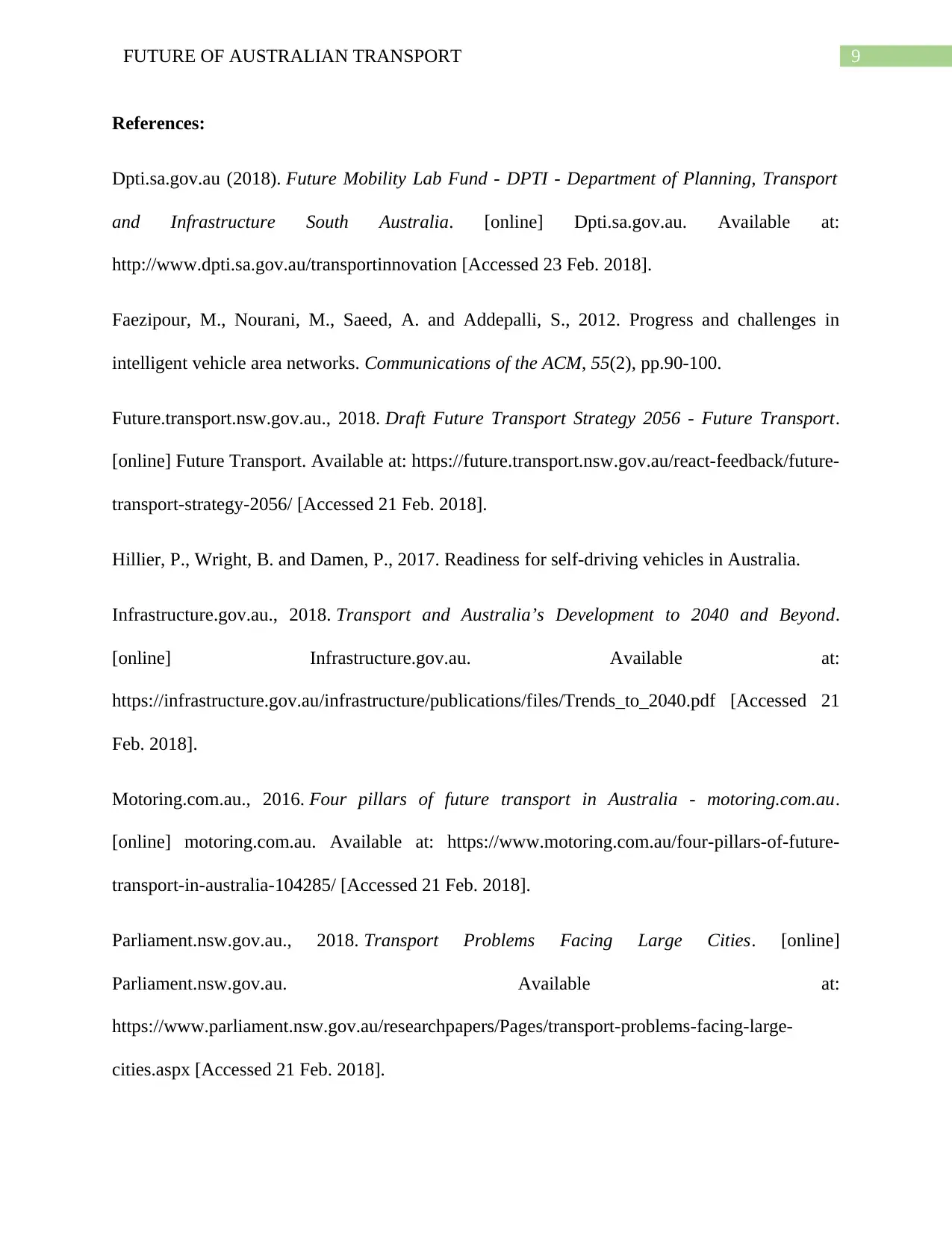
9FUTURE OF AUSTRALIAN TRANSPORT
References:
Dpti.sa.gov.au (2018). Future Mobility Lab Fund - DPTI - Department of Planning, Transport
and Infrastructure South Australia. [online] Dpti.sa.gov.au. Available at:
http://www.dpti.sa.gov.au/transportinnovation [Accessed 23 Feb. 2018].
Faezipour, M., Nourani, M., Saeed, A. and Addepalli, S., 2012. Progress and challenges in
intelligent vehicle area networks. Communications of the ACM, 55(2), pp.90-100.
Future.transport.nsw.gov.au., 2018. Draft Future Transport Strategy 2056 - Future Transport.
[online] Future Transport. Available at: https://future.transport.nsw.gov.au/react-feedback/future-
transport-strategy-2056/ [Accessed 21 Feb. 2018].
Hillier, P., Wright, B. and Damen, P., 2017. Readiness for self-driving vehicles in Australia.
Infrastructure.gov.au., 2018. Transport and Australia’s Development to 2040 and Beyond.
[online] Infrastructure.gov.au. Available at:
https://infrastructure.gov.au/infrastructure/publications/files/Trends_to_2040.pdf [Accessed 21
Feb. 2018].
Motoring.com.au., 2016. Four pillars of future transport in Australia - motoring.com.au.
[online] motoring.com.au. Available at: https://www.motoring.com.au/four-pillars-of-future-
transport-in-australia-104285/ [Accessed 21 Feb. 2018].
Parliament.nsw.gov.au., 2018. Transport Problems Facing Large Cities. [online]
Parliament.nsw.gov.au. Available at:
https://www.parliament.nsw.gov.au/researchpapers/Pages/transport-problems-facing-large-
cities.aspx [Accessed 21 Feb. 2018].
References:
Dpti.sa.gov.au (2018). Future Mobility Lab Fund - DPTI - Department of Planning, Transport
and Infrastructure South Australia. [online] Dpti.sa.gov.au. Available at:
http://www.dpti.sa.gov.au/transportinnovation [Accessed 23 Feb. 2018].
Faezipour, M., Nourani, M., Saeed, A. and Addepalli, S., 2012. Progress and challenges in
intelligent vehicle area networks. Communications of the ACM, 55(2), pp.90-100.
Future.transport.nsw.gov.au., 2018. Draft Future Transport Strategy 2056 - Future Transport.
[online] Future Transport. Available at: https://future.transport.nsw.gov.au/react-feedback/future-
transport-strategy-2056/ [Accessed 21 Feb. 2018].
Hillier, P., Wright, B. and Damen, P., 2017. Readiness for self-driving vehicles in Australia.
Infrastructure.gov.au., 2018. Transport and Australia’s Development to 2040 and Beyond.
[online] Infrastructure.gov.au. Available at:
https://infrastructure.gov.au/infrastructure/publications/files/Trends_to_2040.pdf [Accessed 21
Feb. 2018].
Motoring.com.au., 2016. Four pillars of future transport in Australia - motoring.com.au.
[online] motoring.com.au. Available at: https://www.motoring.com.au/four-pillars-of-future-
transport-in-australia-104285/ [Accessed 21 Feb. 2018].
Parliament.nsw.gov.au., 2018. Transport Problems Facing Large Cities. [online]
Parliament.nsw.gov.au. Available at:
https://www.parliament.nsw.gov.au/researchpapers/Pages/transport-problems-facing-large-
cities.aspx [Accessed 21 Feb. 2018].
Paraphrase This Document
Need a fresh take? Get an instant paraphrase of this document with our AI Paraphraser
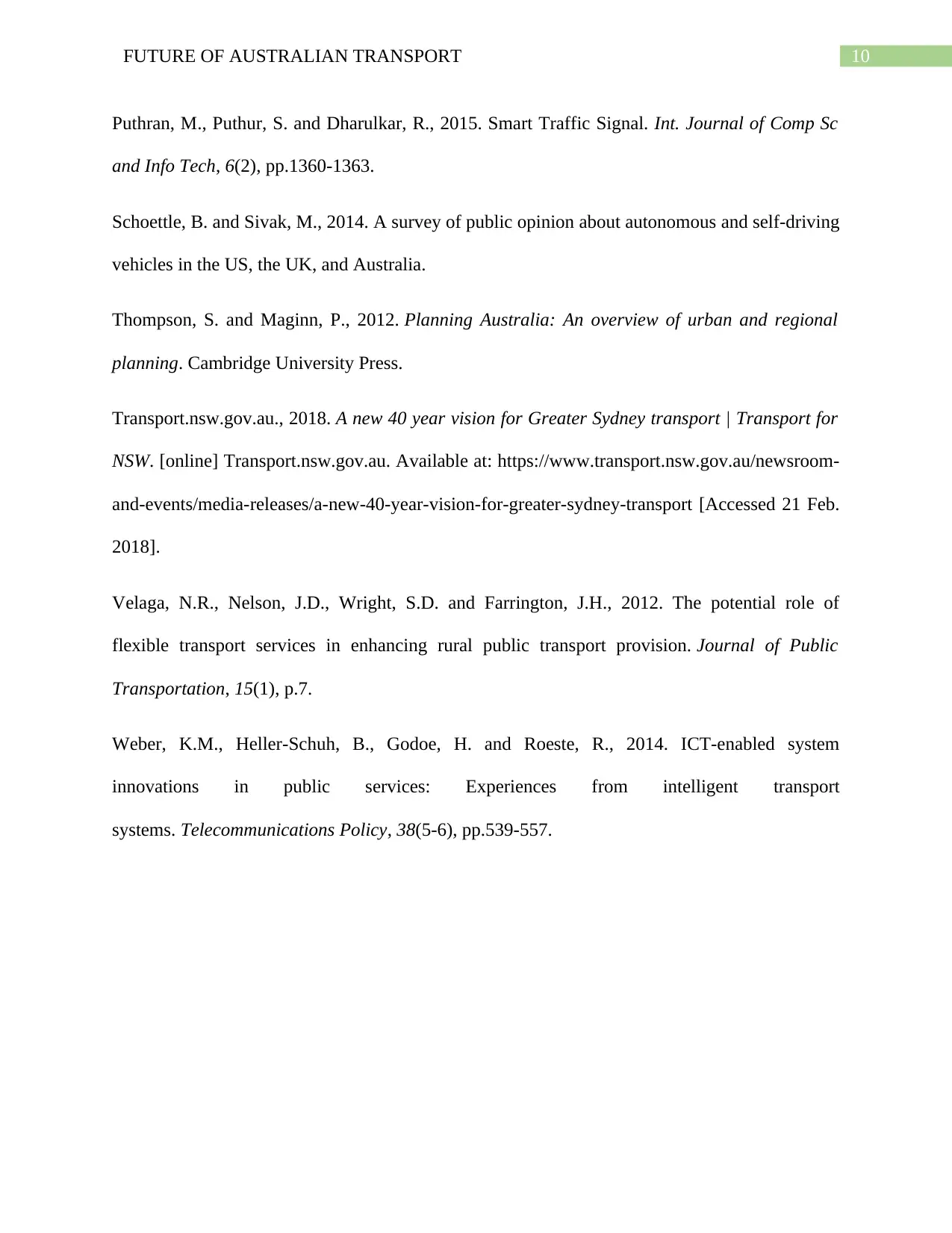
10FUTURE OF AUSTRALIAN TRANSPORT
Puthran, M., Puthur, S. and Dharulkar, R., 2015. Smart Traffic Signal. Int. Journal of Comp Sc
and Info Tech, 6(2), pp.1360-1363.
Schoettle, B. and Sivak, M., 2014. A survey of public opinion about autonomous and self-driving
vehicles in the US, the UK, and Australia.
Thompson, S. and Maginn, P., 2012. Planning Australia: An overview of urban and regional
planning. Cambridge University Press.
Transport.nsw.gov.au., 2018. A new 40 year vision for Greater Sydney transport | Transport for
NSW. [online] Transport.nsw.gov.au. Available at: https://www.transport.nsw.gov.au/newsroom-
and-events/media-releases/a-new-40-year-vision-for-greater-sydney-transport [Accessed 21 Feb.
2018].
Velaga, N.R., Nelson, J.D., Wright, S.D. and Farrington, J.H., 2012. The potential role of
flexible transport services in enhancing rural public transport provision. Journal of Public
Transportation, 15(1), p.7.
Weber, K.M., Heller-Schuh, B., Godoe, H. and Roeste, R., 2014. ICT-enabled system
innovations in public services: Experiences from intelligent transport
systems. Telecommunications Policy, 38(5-6), pp.539-557.
Puthran, M., Puthur, S. and Dharulkar, R., 2015. Smart Traffic Signal. Int. Journal of Comp Sc
and Info Tech, 6(2), pp.1360-1363.
Schoettle, B. and Sivak, M., 2014. A survey of public opinion about autonomous and self-driving
vehicles in the US, the UK, and Australia.
Thompson, S. and Maginn, P., 2012. Planning Australia: An overview of urban and regional
planning. Cambridge University Press.
Transport.nsw.gov.au., 2018. A new 40 year vision for Greater Sydney transport | Transport for
NSW. [online] Transport.nsw.gov.au. Available at: https://www.transport.nsw.gov.au/newsroom-
and-events/media-releases/a-new-40-year-vision-for-greater-sydney-transport [Accessed 21 Feb.
2018].
Velaga, N.R., Nelson, J.D., Wright, S.D. and Farrington, J.H., 2012. The potential role of
flexible transport services in enhancing rural public transport provision. Journal of Public
Transportation, 15(1), p.7.
Weber, K.M., Heller-Schuh, B., Godoe, H. and Roeste, R., 2014. ICT-enabled system
innovations in public services: Experiences from intelligent transport
systems. Telecommunications Policy, 38(5-6), pp.539-557.
1 out of 11
Related Documents
Your All-in-One AI-Powered Toolkit for Academic Success.
+13062052269
info@desklib.com
Available 24*7 on WhatsApp / Email
![[object Object]](/_next/static/media/star-bottom.7253800d.svg)
Unlock your academic potential
Copyright © 2020–2025 A2Z Services. All Rights Reserved. Developed and managed by ZUCOL.





